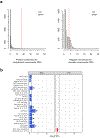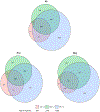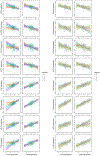Brain gene co-expression networks link complement signaling with convergent synaptic pathology in schizophrenia
- PMID: 33958802
- PMCID: PMC8178202
- DOI: 10.1038/s41593-021-00847-z
Brain gene co-expression networks link complement signaling with convergent synaptic pathology in schizophrenia
Abstract
The most significant common variant association for schizophrenia (SCZ) reflects increased expression of the complement component 4A (C4A). Yet, it remains unclear how C4A interacts with other SCZ risk genes or whether the complement system more broadly is implicated in SCZ pathogenesis. Here, we integrate several existing, large-scale genetic and transcriptomic datasets to interrogate the functional role of the complement system and C4A in the human brain. Unexpectedly, we find no significant genetic enrichment among known complement system genes for SCZ. Conversely, brain co-expression network analyses using C4A as a seed gene reveal that genes downregulated when C4A expression increases exhibit strong and specific genetic enrichment for SCZ risk. This convergent genomic signal reflects synaptic processes, is sexually dimorphic and most prominent in frontal cortical brain regions, and is accentuated by smoking. Overall, these results indicate that synaptic pathways-rather than the complement system-are the driving force conferring SCZ risk.
Conflict of interest statement
Competing interests
The authors declare no competing interests.
Figures


















Similar articles
-
Transcriptome sequencing and genome-wide association analyses reveal lysosomal function and actin cytoskeleton remodeling in schizophrenia and bipolar disorder.Mol Psychiatry. 2015 May;20(5):563-572. doi: 10.1038/mp.2014.82. Epub 2014 Aug 12. Mol Psychiatry. 2015. PMID: 25113377 Free PMC article.
-
Overexpression of schizophrenia susceptibility factor human complement C4A promotes excessive synaptic loss and behavioral changes in mice.Nat Neurosci. 2021 Feb;24(2):214-224. doi: 10.1038/s41593-020-00763-8. Epub 2020 Dec 22. Nat Neurosci. 2021. PMID: 33353966 Free PMC article.
-
Investigating trait variability of gene co-expression network architecture in brain by controlling for genomic risk of schizophrenia.PLoS Genet. 2023 Oct 13;19(10):e1010989. doi: 10.1371/journal.pgen.1010989. eCollection 2023 Oct. PLoS Genet. 2023. PMID: 37831723 Free PMC article.
-
Genetic evidence for role of integration of fast and slow neurotransmission in schizophrenia.Mol Psychiatry. 2017 Jun;22(6):792-801. doi: 10.1038/mp.2017.33. Epub 2017 Mar 28. Mol Psychiatry. 2017. PMID: 28348379 Free PMC article. Review.
-
The complement system: a gateway to gene-environment interactions in schizophrenia pathogenesis.Mol Psychiatry. 2017 Nov;22(11):1554-1561. doi: 10.1038/mp.2017.151. Epub 2017 Aug 1. Mol Psychiatry. 2017. PMID: 28761078 Free PMC article. Review.
Cited by
-
Schizophrenia genomics: genetic complexity and functional insights.Nat Rev Neurosci. 2024 Sep;25(9):611-624. doi: 10.1038/s41583-024-00837-7. Epub 2024 Jul 19. Nat Rev Neurosci. 2024. PMID: 39030273 Review.
-
Cognitive Dysfunction and Prefrontal Cortical Circuit Alterations in Schizophrenia: Developmental Trajectories.Biol Psychiatry. 2022 Sep 15;92(6):450-459. doi: 10.1016/j.biopsych.2022.03.002. Epub 2022 Mar 10. Biol Psychiatry. 2022. PMID: 35568522 Free PMC article. Review.
-
Cerebrospinal fluid concentration of complement component 4A is increased in first episode schizophrenia.Nat Commun. 2022 Nov 3;13(1):6427. doi: 10.1038/s41467-022-33797-6. Nat Commun. 2022. PMID: 36329007 Free PMC article.
-
Human stem cell-based models to study synaptic dysfunction and cognition in schizophrenia: A narrative review.Schizophr Res. 2024 Nov;273:78-97. doi: 10.1016/j.schres.2023.02.029. Epub 2023 Mar 14. Schizophr Res. 2024. PMID: 36925354 Review.
-
A concerted neuron-astrocyte program declines in ageing and schizophrenia.Nature. 2024 Mar;627(8004):604-611. doi: 10.1038/s41586-024-07109-5. Epub 2024 Mar 6. Nature. 2024. PMID: 38448582 Free PMC article.
References
-
- Sullivan PF, Kendler KS & Neale MC Schizophrenia as a complex trait: evidence from a meta-analysis of twin studies. Arch. Gen. Psychiatry 60, 1187–1192 (2003). - PubMed
Publication types
MeSH terms
Grants and funding
- R01 MH110928/MH/NIMH NIH HHS/United States
- U01 MH103365/MH/NIMH NIH HHS/United States
- U01 MH116489/MH/NIMH NIH HHS/United States
- R01 MH121521/MH/NIMH NIH HHS/United States
- U01 MH103346/MH/NIMH NIH HHS/United States
- R56 MH114911/MH/NIMH NIH HHS/United States
- K00 MH119663/MH/NIMH NIH HHS/United States
- U01 MH103339/MH/NIMH NIH HHS/United States
- R01 MH110920/MH/NIMH NIH HHS/United States
- U01 MH116487/MH/NIMH NIH HHS/United States
- R21 MH105881/MH/NIMH NIH HHS/United States
- R01 MH110921/MH/NIMH NIH HHS/United States
- R01 MH110926/MH/NIMH NIH HHS/United States
- U01 MH116488/MH/NIMH NIH HHS/United States
- U01 MH116438/MH/NIMH NIH HHS/United States
- U01 MH116442/MH/NIMH NIH HHS/United States
- R01 MH094714/MH/NIMH NIH HHS/United States
- R56 MH114901/MH/NIMH NIH HHS/United States
- T32 MH073526/MH/NIMH NIH HHS/United States
- R01 MH117292/MH/NIMH NIH HHS/United States
- T32 GM008042/GM/NIGMS NIH HHS/United States
- R21 MH103877/MH/NIMH NIH HHS/United States
- P50 HD103557/HD/NICHD NIH HHS/United States
- R01 MH110905/MH/NIMH NIH HHS/United States
- R01 MH110927/MH/NIMH NIH HHS/United States
- U01 MH116441/MH/NIMH NIH HHS/United States
- T32 NS048004/NS/NINDS NIH HHS/United States
- R21 MH109956/MH/NIMH NIH HHS/United States
- R56 MH114899/MH/NIMH NIH HHS/United States
- U01 MH103392/MH/NIMH NIH HHS/United States
- R01 MH117291/MH/NIMH NIH HHS/United States
- R01 MH117293/MH/NIMH NIH HHS/United States
- R01 MH109677/MH/NIMH NIH HHS/United States
- R01 MH111721/MH/NIMH NIH HHS/United States
- U01 MH103340/MH/NIMH NIH HHS/United States
- R21 MH102791/MH/NIMH NIH HHS/United States
- R01 MH105898/MH/NIMH NIH HHS/United States
- R01 MH123922/MH/NIMH NIH HHS/United States
- R21 MH105853/MH/NIMH NIH HHS/United States
- R01 MH109715/MH/NIMH NIH HHS/United States
- R37 MH085953/MH/NIMH NIH HHS/United States
- U01 MH116492/MH/NIMH NIH HHS/United States
- P50 MH106934/MH/NIMH NIH HHS/United States
LinkOut - more resources
Full Text Sources
Other Literature Sources
Medical
Miscellaneous

